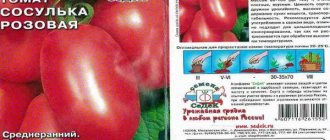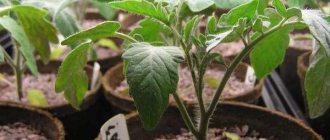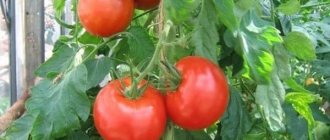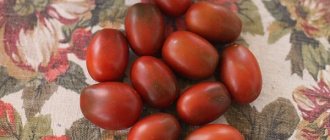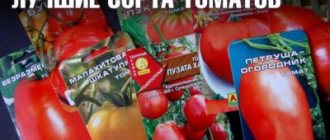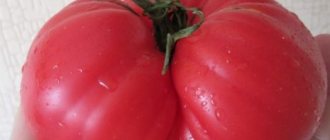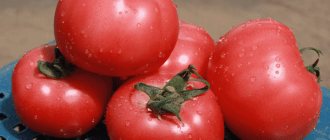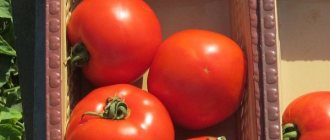There are several reliable Dutch tomato hybrids known. Shakira F1 is special among them, as it is wrist and highly productive. One of the best among those presented in the line. Designed for greenhouse shelters and open beds.
| Height | Landing location | Ripening time | Fruit color | Fruit size | Origin | Fruit shape |
| Medium height | Greenhouse, Open ground | Mid-early | Reds | Large | Hybrid | Flat-round |
Description – brief description
The originator of the hybrid is Monsanto (Holland). The culture belongs to medium-sized indeterminates. The bushes should be formed into 2 stems, periodically carrying out pinching. Tomatoes are distinguished by their moderate foliage; 4-6 large tomatoes are tied on powerful clusters of the plant. The bushes must be tied to a support. The time until the first fruits of the hybrid appear is 112-116 days.
Main characteristics of tomatoes:
- fruits are flat-round, glossy red, “Beef” type (fleshy);
- the skin is dense and not prone to cracking;
- the pulp is juicy;
- seed chambers – 4-5;
- the taste is pleasantly sweet with a slight sourness.
Attention! Shakira F1 tomatoes are delicious fresh (salads, juices), they are also great for preparations (mashed potatoes, ketchups, lecho, pastes). The fruits are also pickled and salted.
According to ripening time | By type of growth | By type of use | By growing method | Fruit weight in (g) | Yield (kg/m²) | Fetal characteristics |
| Mid-ripe, ripens at 112-116 days | Indeterminate (120-150 cm) | Universal | In open ground, in greenhouses | 280-300 g, individual specimens up to 400 g | 10-12 kg in a greenhouse, 9 kg in open ground | Flat-rounded fruits, with slight ribbing, expressive red hue, with dense skin, fleshy |
Pros and cons of the Shakira variety
Pros:
- No sharp thorns.
- This is a frost-resistant variety.
- Has a bright color.
- Even after heavy rain, the buds of this plant will not be damaged.
- The variety is resistant to fungal and bacterial diseases.
- Has dense buds.
- “Cut” variety (stands for a long time in a vase).
- The variety is very resistant to pests.
- The perennial blooms profusely.
- Easy to care for.
- Flowers do not fade in sunlight.
Minuses:
Faces late blight.
Advantages and disadvantages
A hybrid Dutch variety, unpretentious and productive, pleases amateur gardeners. Vivid photos of the harvest obtained from summer cottages demonstrate the beauty of large tomatoes. They offer many advantages:
- spectacular large fruits;
- excellent taste;
- productivity;
- ease of cultivation;
- excellent transportability of tomatoes;
- drought resistance.
Attention! The advantages of Shakira tomatoes also include resistance to traditional diseases - cladosporiosis, tobacco mosaic, fusarium wilt.
Among the disadvantages, we can note the need for regular fertilizing.
Pests
Microscopic spiders have appeared on the plant, and the rose is gradually becoming covered with cobwebs, what should I do? Spider mite
Are small green insects destroying your rose? Effective methods of pest control. Green rose aphid
Caterpillars have appeared on the rose and are twisting the leaves of the plant, how to deal with the pest Rosen leaf roller
Flat bumps have appeared on the shoots of the rose or on the underside of the foliage, how to deal with the pest Rosen scale insect
The Shakira variety will look especially impressive near tall conifers and evergreens, near juniper, pine or cypress.
Features of agricultural technology
The best option for growing hybrid racemose tomatoes is the seedling method. It is advisable to adhere to the recommendations of the originator of the culture:
- Seeds are sown in March. They are buried to a depth of about 1 cm in compacted soil. Moisten with warm water.
- Cover with film.
- The container is kept in a warm place (about 24° C).
- Picking is carried out when the 2nd pair of true leaves appears. 60-65-day old tomato seedlings are planted in greenhouses or unprotected soil (in the absence of frost). The bushes contain 6-7 leaves and a raceme with a flower ovary.
- 4-5 bushes are placed per 1 m², the distance between the rows is 50-60 cm.
The nuances of growing large-fruited tomatoes:
- Regular fertilizing with complex fertilizers (twice a month).
- Moderate watering.
- Formation of a bush into 2 stems, timely removal of emerging stepsons, which contributes to the formation of large fruits.
- Preparation of support (in the form of pegs or trellises).
What do bushes and fruits look like?
The botanical description of the variety is mid-early, since after planting the seedlings in the ground, 100–105 days pass before the tomatoes are harvested. The characteristics of the bushes are indeterminate, that is, their stems can grow unlimitedly after setting tomatoes, so they need to be tied up and pinched, and also standard.
The tomato contains 5 - 6% dry matter, the fruit itself is fleshy, has medium density, very sweet, and does not crack.
The beneficial properties of the fruits are that they contain vitamins B1, B6, C (strengthens the immune system), since they contain more sugar than red vegetables, they can be eaten even by those who have diseases of the stomach and intestines.
The tomato has fruits of a bright crimson color, in most cases large. They have an even shape of an almost perfect circle, the outside surface is characterized by slight ribbing. The weight of the fruit is surprising in its size and reaches an average of 500 grams, but there are also larger fruits. The fleshy pulp has a good taste, and the tomato has almost no seeds.
Reviews
The large-fruited racemose hybrid has become popular among gardeners. On thematic forums, summer residents leave reviews about fairly unpretentious tomatoes.
- Nina from Stavropol region. Shakir's tomato seeds pleased with excellent germination. I pinched the stem, the strong bushes reached a size of 1.5 m. As it grew, the crop was tied to a trellis. The fruits were perfectly stored, and I made a lot of preparations from them.
- Zinaida from Voronezh region. Shakira F1 was grown in an indoor greenhouse. The tomatoes pleased us with an excellent harvest and beautiful large fruits. We managed to make a lot of juice and tomato paste from juicy tomatoes.
- Elena from the Saratov region. A neighbor in the country shared the seeds. The seedlings grew strong. I planted it in open ground. I often fed the bushes. The result did not disappoint - everyone in the household liked the tasty, juicy tomatoes. I will grow it next year too.
A large-fruited Dutch reliable hybrid, impressive in size and unpretentiousness, will be a godsend for many summer residents who want to get magnificent tomatoes in their garden beds.
Gardeners' opinions
I didn’t have any varieties of roses; I first got the Shakira variety about 5 years ago. I was given a large bush that began to bloom profusely. In the first year it grew by 90 cm. The roses are very beautiful with dense buds and completely without thorns. I should also note that this is a cut variety, which I am absolutely delighted with (the flowers lasted in the vase for about two weeks). But the plant survived the first winter very hard, it was very frozen (I covered it, and it wasn’t very cold outside). After wintering, she did not wake up, she was completely frozen. I really liked the variety, but I didn’t get along with it. It is possible that this French woman will take root better in the southern regions of our country. I would really like to find a similar variety.
Antonina Lipetsk
For a long time now, my wife and I have turned our plot into a real garden. Friends gave us the Shakira variety of rose. A very beautiful variety, with a bright crimson color and lush buds. In winter, we did not cover our roses with anything; the roses survived the winter. We were amazed at the resistance to spider mites; many of our plants deteriorated precisely because of them.
Igor Sochi
I have had the Shakira variety for a long time. A completely non-problematic variety, resistant to pests and without sharp thorns. For several years with “Shakira” I encountered only one problem – late blight. Thanks to regular treatments with Profit, late blight was very quickly defeated. I had no more problems growing this perennial.
Alina Moscow
Growing seedlings
Seedlings are sown in the first ten days of March. To do this, prepare containers with soil intended for growing tomato and pepper seedlings. Soil is poured, about 10-12 cm high, and grooves are drawn.
Read also: Buns with dried apricots and raisins
Seeds of the Shakira F1 variety can not be soaked and treated with potassium permanganate, but carefully laid out on the grooves every 2 cm, covered with soil one to one and a half centimeters. Lightly water with melt water, cover with film, and place in a warm place for germination. After 5-7 days, shoots will begin to appear.
The film must be removed and the box with seedlings placed on the windowsill, closer to the light. After 2 true leaves appear, it is recommended to pick the plants. Tomatoes should be planted in separate pots. If there is not enough light, it is advisable to illuminate it with a lamp.
When more favorable conditions arrive (around the beginning of May), the seedlings are planted in greenhouses. After planting, it is recommended to water and loosen the soil well. If the seedlings are developed and tall, then it is recommended to immediately attach a trellis near each plant.
Useful tips
During plant growth, it is recommended to hill them to form an additional root system. The first time is approximately on the 10th day of disembarkation, and the second time is on the 18-20th day.
In order for tomatoes to produce a good harvest, it is recommended to form 2 stems from them. It is imperative to monitor the growth of stepchildren, which must be periodically removed.
During the entire growing season, it is recommended to remove weeds, loosen and water the plants. Watering is most active when the first and then the second flower clusters grow and bloom.
Don’t forget to feed it 2 times a month with complex fertilizers.
Shakira tomato varieties have only positive reviews. Everyone who grew it was satisfied, noting the high yield, excellent taste, and resistance to disease. Tomatoes do not require special care; the fruits are large and hang beautifully on the cluster.
How are tomatoes grown?
Seeds are planted in early March. You must first prepare containers for planting. They are filled with special soil for seedlings of peppers and tomatoes. The soil is poured into containers 10-12 cm deep. Then furrows are made for sowing. The seeds do not need to be soaked or treated with potassium permanganate. They are carefully buried in the soil in prepared furrows every 2 cm. After sowing, they are sprinkled with soil 1-1.5 cm thick.
Then you need to water the soil with warm water, cover it with cellophane, and place the container with the seedlings in a warm room. Sprouts will form in 5-7 days and will begin to emerge to the surface.
Proper planting and care
Seedlings need to be taken care of in advance. Buy Hazel May seeds on our website and don’t worry about timely planting. The seeds must be soaked in potassium permanganate, after an hour or two, rinse well and immerse in a growth stimulator. Keep in a well-lit place. When planting seedlings on the soil, we recommend planting 3-4 pieces per 1 square meter. m. You need to water with warm water and preferably at the root. During growth, saturate the soil with various fertilizers, loosen and remove weeds, and monitor pathogenic flora.
What sets Hazel May apart from other tomatoes is the almost fruity sweetness of the fruit. But even this variety will not be sweet in low light. To increase sweetness, sunlight is needed (in greenhouses, use additional lighting). Phosphorus-potassium mixtures will also help increase sugar content. Use 2-3 times a week.
